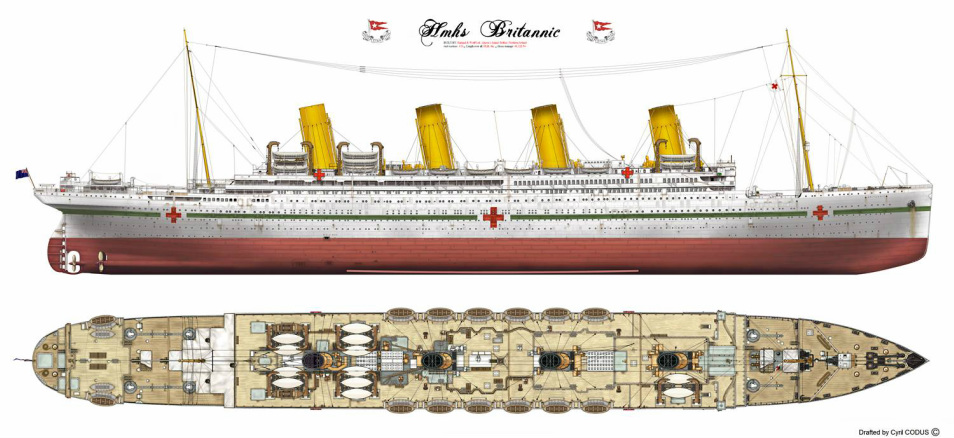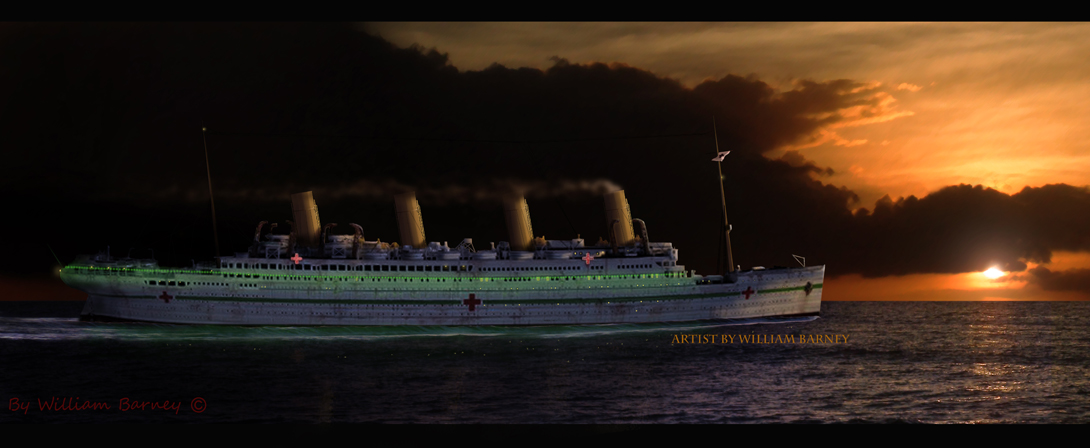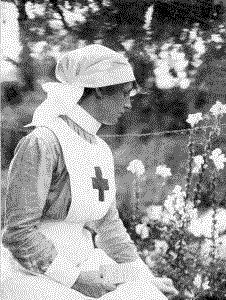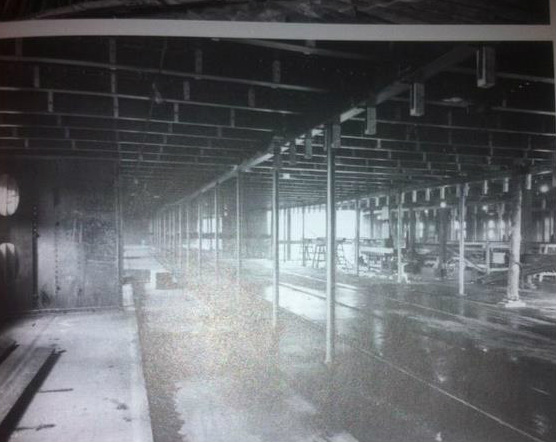HOSPITAL SHIP
By Michail Michailakis
Ocean liners at war
In August 1914, the Triple Entente (Great Britain, France and Russia) declared war on the Central Powers (Germany and Austria-Hungary). Everyone had assumed that the war would be over by Christmas but soon it was obvious that this was not the case. Immediately, all shipyards with Admiralty contracts were given top priority to use available raw materials. All civil contracts (including the Britannic) were slowed down. The military authorities requisitioned a large number of ships as armed merchant cruisers or for troop transport. The Admiralty was paying the companies for the use of their vessels but the risk of losing a ship during military operations was high. However, the big ocean liners were not taken for military use as smaller vessels were much easier to operate. The White Star decided to withdraw the Olympic from service until the danger had passed. The Olympic returned to Belfast on November 3, 1914. Next to her, work on the Britannic continued slowly as her builders had given full priority to Admiralty orders.
The need for increased tonnage became crucial as military operations extended to the eastern Mediterranean, where a new German ally entered the war, the Ottoman Empire (modern Turkey). In May of 1915, the Britannic completed the mooring trials of her engines. In case of an emergency she could be ready to sail after four weeks. That same month the Lusitania was torpedoed near the Irish coast by a German submarine while returning from New York. No warning was given before the torpedo's launch. The Cunard liner sank in only eighteen minutes with the loss of 1200 people. Cunard and White Star remained with two giant liners each. In June, the Admiralty finally decided to use the large ocean liners as troop transports for the Gallipoli campaign (also called the "Dardanelles service"). The first to go were the Mauretania and the Aquitania. Soon everyone realised that the Gallipoli landings would be a failure. The number of casualties reached appalling numbers and now the need was for larger hospital ships. In August the Aquitania was diverted to hospital ship duties (her place as a troop transport was taken by the Olympic in September). The Britannic couldn't lie useless in Belfast anymore and in November 13, 1915 she was requisitioned as a hospital ship
The Britannic had to be modified for a second time. The few fittings already installed were placed in storage. The public rooms on the upper decks were transformed in wards for the wounded. Lower on the ship, the large first class dining room and the reception rooms became operating theatres and main wards. The medical personnel would occupy the B-deck cabins, while the rest medical orderlies and the less wounded patients would be accommodated on the lower decks. Surviving photos show that the partially covered first class promenade was also used as a ward. With all these modifications the ship's tonnage arrived at 48.158 tons and she could carry 3.309 casualties (the second largest capacity for a hospital ship after the Aquitania).
One of the major problems of the ship's conversion was that only five (of eight) sets of the giant lifeboat davits had been installed. In order to reach the required lifeboat capacity, six Wellin type davits (like those used on Titanic) were installed on both sides of the boat deck and two further astern on the poop deck. Each could handle two lifeboats, one open and one collapsible. This was a temporary solution for the war period. With this arrangement, the Britannic had 58 lifeboats on board. The hull was painted in white with a green band from stem to sternpost broken in three places by large red crosses. This color scheme was the international identification of hospital ships. Protection at night was crucial and the ship needed to be clearly identified. For this purpose two large red crosses were placed on both sides of the boat deck. Each one was lit at night along with a band of green electric bulbs, covering more than 2/3 of the ship's length. This way it was impossible for enemy vessels to be mistaken about the status of the Britannic.
The need for increased tonnage became crucial as military operations extended to the eastern Mediterranean, where a new German ally entered the war, the Ottoman Empire (modern Turkey). In May of 1915, the Britannic completed the mooring trials of her engines. In case of an emergency she could be ready to sail after four weeks. That same month the Lusitania was torpedoed near the Irish coast by a German submarine while returning from New York. No warning was given before the torpedo's launch. The Cunard liner sank in only eighteen minutes with the loss of 1200 people. Cunard and White Star remained with two giant liners each. In June, the Admiralty finally decided to use the large ocean liners as troop transports for the Gallipoli campaign (also called the "Dardanelles service"). The first to go were the Mauretania and the Aquitania. Soon everyone realised that the Gallipoli landings would be a failure. The number of casualties reached appalling numbers and now the need was for larger hospital ships. In August the Aquitania was diverted to hospital ship duties (her place as a troop transport was taken by the Olympic in September). The Britannic couldn't lie useless in Belfast anymore and in November 13, 1915 she was requisitioned as a hospital ship
The Britannic had to be modified for a second time. The few fittings already installed were placed in storage. The public rooms on the upper decks were transformed in wards for the wounded. Lower on the ship, the large first class dining room and the reception rooms became operating theatres and main wards. The medical personnel would occupy the B-deck cabins, while the rest medical orderlies and the less wounded patients would be accommodated on the lower decks. Surviving photos show that the partially covered first class promenade was also used as a ward. With all these modifications the ship's tonnage arrived at 48.158 tons and she could carry 3.309 casualties (the second largest capacity for a hospital ship after the Aquitania).
One of the major problems of the ship's conversion was that only five (of eight) sets of the giant lifeboat davits had been installed. In order to reach the required lifeboat capacity, six Wellin type davits (like those used on Titanic) were installed on both sides of the boat deck and two further astern on the poop deck. Each could handle two lifeboats, one open and one collapsible. This was a temporary solution for the war period. With this arrangement, the Britannic had 58 lifeboats on board. The hull was painted in white with a green band from stem to sternpost broken in three places by large red crosses. This color scheme was the international identification of hospital ships. Protection at night was crucial and the ship needed to be clearly identified. For this purpose two large red crosses were placed on both sides of the boat deck. Each one was lit at night along with a band of green electric bulbs, covering more than 2/3 of the ship's length. This way it was impossible for enemy vessels to be mistaken about the status of the Britannic.
The White Star line selected Captain Charles Alfred Bartlett as the ship's first commander. Bartlett was also known as "Iceberg Charlie" for his capacity to "smell" ice. He had joined the White star line in 1894 and in 1903 he had received his first command. Since 1912 he had worked as Marine Superintendent at Belfast and had watched the building of the Britannic from the first day her keel was laid. On December 6, 1915 the Admiralty unofficially informed the Germans about the status of the Britannic and two days later the ship successfully completed her trials and she was handed over to the White Star Line for registration. On December 11, 1915, the ship (commanded by Captain J. Ranson) left Belfast for Liverpool, where she was commissioned as His Majesty's Hospital Ship (HMHS) G618 two days later. Captain Bartlett officially took command of the ship while medical equipment was still being installed. Finally, on December 23, 1915, "the most wonderful hospital ship that ever sailed the seas" was ready for her maiden voyage at a final cost of £1,947,797. At this time the Britannnic was the largest ship in the world in active service.
After the end of the ill-fated Gallipoli campaign there was no need for the giant liners in the eastern Mediterranean and the Mauretania, the Aquitania and the Britannic were paid off by the Admiralty. On June 6, 1916 the Britannic was officially released from war service. However, in September 1916 the Allied troops stationed in the Greek port of Salonica started a new offensive in the Macedonian front, combined with two attacks against the Turks in Mesopotamia and Palestine. Very soon the need for large hospital ships became evident. The first to be recalled for service was the Aquitania, followed by the Britannic on August 28, 1916.
Voyage chronology of the HMHS Britannic
ROUND TRIP 1 (LIVERPOOL-NAPLES-MOUDROS-SOUTHAMPTON)
Departure (Liverpoool): Dec. 23, 1915
Arrival (Naples): Dec. 28, 1915
Departure (Naples): Dec. 29, 1915
Arrival (Moudros): Dec. 31, 1915
Departure (Moudros): Jan. 3, 1916
Arrival (Southampton): Jan.9, 1916
Events: The departure for the maiden voyage was a quiet one. No celebrations, no orchestras, no joyful passengers. The medical personnel took their assigned posts and as the ship sailed for Moudros (the Allied base for the Gallipoli campaign) everyone followed the routine work of a hospital ship: The hospital areas of the ship had to be disinfected and the 3309 beds had to be prepared in order to receive the wounded.
The ship made a stop at Naples in order to take enough coal and water for the non-stop return to Southampton. At Moudros patients were embarked from smaller hospital ships.
Jan. 2, 1916: Private A. Howe died of tubercular disease. His body was landed on Lemnos for burial.
Jan. 5, 1916: Able Seaman (RND) Samuel L. Jones jumped overboard around 6:00am at 37.10 N, 11.25 E. According wartime regulations the ship couldn't stop and search for him. It was assumed he was dead.
Jan. 9, 1916: Private C. Vincent (aged 21) died of tuberculosis near the English coast.
ROUND TRIP 2 (SOUTHAMPTON-NAPLES-SOUTHAMPTON)
Departure (Southampton): Jan. 20, 1916
Arrival (Naples): Jan. 25, 1916
Departure (Naples): Feb. 4, 1916
Arrival (Southampton): Feb.9, 1916
Events: When the ship arrived at Naples a signal from Cairo instructed Bartlett to remain in port and take on wounded from the hospital ships Grantully Castle, Formosa, Essequibo and Nevasa. During that stop the Britannic was inspected by the American Ambassador after an invitation by Captain Bartlett. The medical staff of the American ship USS Des Moines was also invited. Another inspection was made by the Neapolitan Sanitary Authorities who complained about dangers of infection and suggested that the ship should use the porting facilities of Augusta in Sicily.
ROUND TRIP 3 (SOUTHAMPTON-NAPLES-AUGUSTA-SOUTHAMPTON)
Departure (Southampton): Mar. 20, 1916
Arrival (Naples): Mar. 25, 1916
Departure (Naples): Mar. 27, 1916
Arrival (Augusta): Mar. 28, 1916
Departure (Augusta): Mar. 30, 1916
Arrival (Southampton): Apr. 4, 1916
Events: At Augusta wounded were loaded from smaller hospital ships. Private R. Pask died of diabetes shortly before arriving at Southampton.
After this voyage the Britannic remained anchored off Cowes for a brief period and then returned to Belfast (May 17, 1916) in order to be converted into a passenger liner. After her recall into war service she was reconverted into a hospital ship and returned to Cowes (September 9, 1916).
ROUND TRIP 4 (COWES-NAPLES-MOUDROS-SOUTHAMPTON)
Departure (off Cowes): Sep. 24, 1916
Arrival (Naples): Sep. 29, 1916
Departure (Naples): Oct. 1, 1916
Arrival (Moudros): Oct. 3, 1916
Departure (Moudros): Oct. 5, 1916
Arrival (Southampton): Oct. 11, 1916
Events: At Moudros wounded were loaded from smaller hospital ships. Corporal J. Seddon died during the return voyage to England.
ROUND TRIP 5 (SOUTHAMPTON-NAPLES-MOUDROS-SOUTHAMPTON)
Departure (Southampton): Oct. 20, 1916
Arrival (Naples): Oct. 25, 1916
Departure (Naples): Oct. 26, 1916
Arrival (Moudros): Oct. 28, 1916
Departure (Moudros): Oct. 30, 1916
Arrival (Southampton): Nov.6, 1916
Events: The RAMC (Royal Army Medical Corps) had requested permission to use the Britannic for transport of medical personnel and supplies. The Admiralty agreed and the Britannic departed with some 483 of extra medical personnel and many tons of extra medical supplies for Egypt, Malta, Salonica, India and Mesopotamia. One of the new "passengers" was famous writer Vera Brittain (then serving as a VAD nurse), who later mentioned this trip in her best-seller book Testament Of Youth. At Moudros wounded were loaded from smaller hospital ships. Corporal George Firth Hunt died of dysentery and heart failure during the return voyage to England.
ROUND TRIP 6 (SOUTHAMPTON-NAPLES-MOUDROS-SOUTHAMPTON)
Departure (Southampton): Nov. 12, 1916
Arrival (Naples): Nov. 17, 1916
Departure (Naples): Nov. 19, 1916
Events: Sank on November 21, 1916 off the Greek island of Kea with the loss of 30 people (21 crew, 9 RAMC).
Departure (Liverpoool): Dec. 23, 1915
Arrival (Naples): Dec. 28, 1915
Departure (Naples): Dec. 29, 1915
Arrival (Moudros): Dec. 31, 1915
Departure (Moudros): Jan. 3, 1916
Arrival (Southampton): Jan.9, 1916
Events: The departure for the maiden voyage was a quiet one. No celebrations, no orchestras, no joyful passengers. The medical personnel took their assigned posts and as the ship sailed for Moudros (the Allied base for the Gallipoli campaign) everyone followed the routine work of a hospital ship: The hospital areas of the ship had to be disinfected and the 3309 beds had to be prepared in order to receive the wounded.
The ship made a stop at Naples in order to take enough coal and water for the non-stop return to Southampton. At Moudros patients were embarked from smaller hospital ships.
Jan. 2, 1916: Private A. Howe died of tubercular disease. His body was landed on Lemnos for burial.
Jan. 5, 1916: Able Seaman (RND) Samuel L. Jones jumped overboard around 6:00am at 37.10 N, 11.25 E. According wartime regulations the ship couldn't stop and search for him. It was assumed he was dead.
Jan. 9, 1916: Private C. Vincent (aged 21) died of tuberculosis near the English coast.
ROUND TRIP 2 (SOUTHAMPTON-NAPLES-SOUTHAMPTON)
Departure (Southampton): Jan. 20, 1916
Arrival (Naples): Jan. 25, 1916
Departure (Naples): Feb. 4, 1916
Arrival (Southampton): Feb.9, 1916
Events: When the ship arrived at Naples a signal from Cairo instructed Bartlett to remain in port and take on wounded from the hospital ships Grantully Castle, Formosa, Essequibo and Nevasa. During that stop the Britannic was inspected by the American Ambassador after an invitation by Captain Bartlett. The medical staff of the American ship USS Des Moines was also invited. Another inspection was made by the Neapolitan Sanitary Authorities who complained about dangers of infection and suggested that the ship should use the porting facilities of Augusta in Sicily.
ROUND TRIP 3 (SOUTHAMPTON-NAPLES-AUGUSTA-SOUTHAMPTON)
Departure (Southampton): Mar. 20, 1916
Arrival (Naples): Mar. 25, 1916
Departure (Naples): Mar. 27, 1916
Arrival (Augusta): Mar. 28, 1916
Departure (Augusta): Mar. 30, 1916
Arrival (Southampton): Apr. 4, 1916
Events: At Augusta wounded were loaded from smaller hospital ships. Private R. Pask died of diabetes shortly before arriving at Southampton.
After this voyage the Britannic remained anchored off Cowes for a brief period and then returned to Belfast (May 17, 1916) in order to be converted into a passenger liner. After her recall into war service she was reconverted into a hospital ship and returned to Cowes (September 9, 1916).
ROUND TRIP 4 (COWES-NAPLES-MOUDROS-SOUTHAMPTON)
Departure (off Cowes): Sep. 24, 1916
Arrival (Naples): Sep. 29, 1916
Departure (Naples): Oct. 1, 1916
Arrival (Moudros): Oct. 3, 1916
Departure (Moudros): Oct. 5, 1916
Arrival (Southampton): Oct. 11, 1916
Events: At Moudros wounded were loaded from smaller hospital ships. Corporal J. Seddon died during the return voyage to England.
ROUND TRIP 5 (SOUTHAMPTON-NAPLES-MOUDROS-SOUTHAMPTON)
Departure (Southampton): Oct. 20, 1916
Arrival (Naples): Oct. 25, 1916
Departure (Naples): Oct. 26, 1916
Arrival (Moudros): Oct. 28, 1916
Departure (Moudros): Oct. 30, 1916
Arrival (Southampton): Nov.6, 1916
Events: The RAMC (Royal Army Medical Corps) had requested permission to use the Britannic for transport of medical personnel and supplies. The Admiralty agreed and the Britannic departed with some 483 of extra medical personnel and many tons of extra medical supplies for Egypt, Malta, Salonica, India and Mesopotamia. One of the new "passengers" was famous writer Vera Brittain (then serving as a VAD nurse), who later mentioned this trip in her best-seller book Testament Of Youth. At Moudros wounded were loaded from smaller hospital ships. Corporal George Firth Hunt died of dysentery and heart failure during the return voyage to England.
ROUND TRIP 6 (SOUTHAMPTON-NAPLES-MOUDROS-SOUTHAMPTON)
Departure (Southampton): Nov. 12, 1916
Arrival (Naples): Nov. 17, 1916
Departure (Naples): Nov. 19, 1916
Events: Sank on November 21, 1916 off the Greek island of Kea with the loss of 30 people (21 crew, 9 RAMC).
Interior layout of HMHS Britannic
Since no plans of her conversion seem to have survived, it is impossible to know in detail the actual layout of the interiors of the Britannic as a hospital ship. The best source of information is a description left by RAMC Private Percy Tyler and it can be found in Simon Mills' book Britannic: Hostage To Fortune. Using this description as a guide, along with data taken from surviving photographs and other personal accounts, we can create a general picture of the interiors without being speculative.
A DECK
A DECK
"...on A Deck, was the Company Office, the officers and nurses quarters, and the officers wards." (P.Tyler's account)
Starting aft, there are four possible areas for the location of the Company Office: the Verandah & Palm Court Cafe, the First Class Smoke Room, the First Class Lounge and the Reading and Writing Room. According to the surviving accounts the cabins were furnitured and very comfortable. There is also photographic evidence that the two enclosed First Class Promenades (one on each side of the deck) had been converted into Officers' wards.
B DECK
B DECK
"B Deck aft was the promenade portion for the RAMC, where also was the officers smoke room. Amidships were wards and for'ard some ship's quarters." (P.Tyler's account)
Starting aft, there were two areas originally intended for smoke rooms: the Third Class Smoke Room and the Second Class Smoke Room, with the latter being considerably bigger. Between these two rooms was the RAMC promenade area. Since the original plans show that the area amidships was to be occupied by a restaurant, a reception room and a large group of cabins it's safe to assume that most of them were largely incomplete in order to create large spaces, used for wards and medical facilities.
C DECK
C DECK
"C Deck aft contained the isolation wards, the RAMC mess and parade ground. Amidships were more nurses' quarters and for'ard wards." (P.Tyler's account)
The isolation wards fit perfectly with the location of the areas originally intended for the ship's hospital and the Third Class General Room. These areas were separated from the rest of the deck facilities by the Third and Second Class promenades (the RAMC parade ground). In this area was also located the large space intended for the Second Class Library, which is the ideal candidate for the RAMC mess. The original plans show that amidships and forward the deck would be occupied only by cabins but from the description it's impossible to know which of them were converted into wards.
D DECK
D DECK
"D Deck held the patients' large dining hall, wards and RAMC lavatories." (P.Tyler's account)
"There was accommodation of 288 on our D Deck. There again we had one huge deck, nothing down the middle, just one enormous part of the deck. Two rows of portholes, one each side. It's been intended for First Class Dining Room and Lounges. Now known as Hickeys (?) after the designer of the ship, as a hospital ship. So, it was carefully designed. It was a lovely big ward." (Nurse Daisy Spickett's audio interview, Imperial War Museum Sound Archive)
According to the ship's plans the patient's dining hall can be no other than the area intended for the Second Class Dining Saloon, while Nurse Daisy Spickett gives valuable details regarding the use and patient capacity of the areas intended for the First Class Dining Saloon and Lounges. Without doubt this ward was enormous but E Deck had wards with largest patient capacity. The audio interview of Daisy Spickett offers the only hint on who designed the hospital ship layout but research on that subject has been inconclusive so far.
E DECK/F DECK/G DECK
E DECK/F DECK/G DECK
"E Deck had K and H wards, the two largest on the boat, and the main gallyway, which stretched from for'ard to aft known as "Scotland Road". Walking along here starting for'ard brought you to ship's quarters, and down two decks to No.1 barrack room which held about 90 of the Corp staff; returning to "Scotland Road" brought you past more lavatories, scouts and stewards quarters. Passing on along the passage were crews quarters and passageways to engineers rooms and the stokeholds, lifts etc. Halfway along and again down two decks, G Deck was No.2 barrack room; back again along the road and down again to F Deck found No.3 barrack room and down to G Deck No.4 barrack room aft. There were three passenger and three cot lifts all working from "Scotland Road" to the Boat Deck six decks up." (P.Tyler's account)
"[....] were the 426 beds of F,L,M,N, and V wards, located forward on the starboard side of F and G decks. These wards consisted mostly of two tier cots [....]" (passage from Simon Mills' "Hostage to Fortune" with info provided by the account of RAMC doctor Harold Goodman)
Originally, E and F decks were planned to have the largest number of cabins. From the descriptions it seems that E Deck conserved most of its original layout in order to accommodate the ship's crew but it also had the ship's two largest wards. F Deck seems to have received more modifications in order to host barrack room No.3 (and probably No. 2 too -see description of G Deck) and several wards forward. G Deck was the lowest deck with accommodations and since the available space was limited due to the casings of the engine and boiler rooms it's easier to identify the areas. Forward, the Third Class cabins on the port side were converted into barrack room No.1, since we know that the cabins on the starboard side were converted into wards. Amidships G Deck was occupied only by boiler casings, so it would be impossible for barrack room No.2 to be located "halfway along" Scotland Road. It seems that Percy Tyler got the location of this barrack room wrong and that it was most probably located on F Deck or further aft on G Deck. There is no mystery regarding the location of barrack room No.4, which could only be located somewhere in the area intended for the Third Class cabins aft of the Turbine Engine casing.





